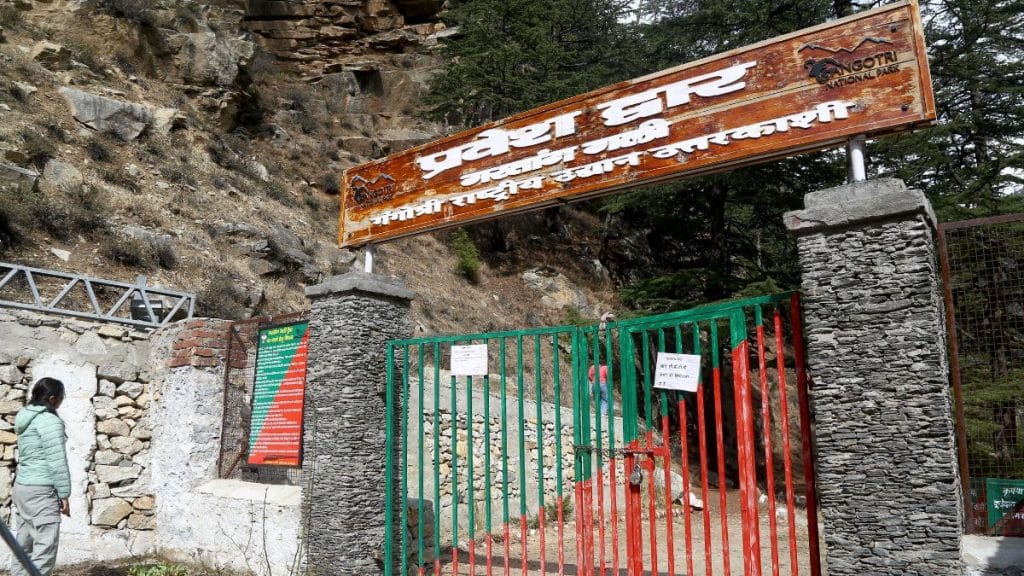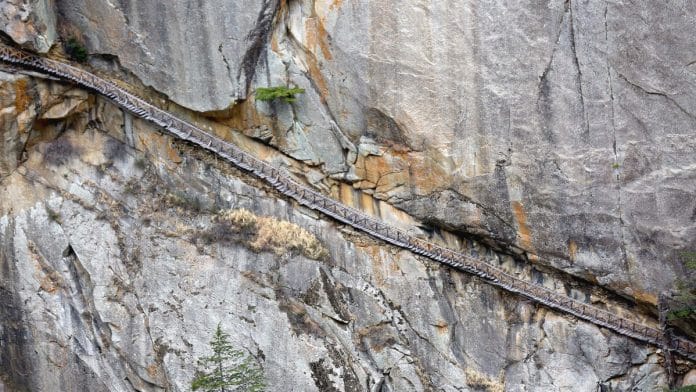Nelong: Half a dozen travellers stand outside the main gate of Gangotri National Park in Uttarakhand’s Uttarkashi district. All they want is to catch a glimpse of a 150-year-old wooden bridge that was in ruins for nearly 60 years after the 1962 India-China war. It has now been renovated and opened for tourists.
“We have seen the photos of the bridge on social media. It is amazing and surprising to build such a bridge between rocky snow-capped mountains. When I planned the trip to Gangotri with my family, visiting Gartang Gali was on the list,” said Mukesh Singh, who had come to visit the iconic Gartang Gali from Saharanpur, Uttar Pradesh. The local people call it a chor rasta (passage of thieves).
Despite the national park gates being shut, some of the tourists climbed over the boundary to see the bridge. They shared tales of the bridge’s storied past and its breathtaking beauty.
Its delicate silhouette is a striking contrast to the rugged grandeur of its surroundings.
The centuries-old wooden bridge in Nelong Valley is located on the ancient Indo-Tibet Silk Road trade route. After the war, the passage fell into disrepair, and portions of the bridge had collapsed.
It opened again for the public in 2021 after the completion of a restoration project that began in 2020. It was part of the Modi government’s push for border tourism.

Now, Gartang Gali is a popular tourist destination in Uttarakhand. Every year, more than 5,000 people visit the site, said forest officials.
“I have seen it in a dilapidated situation since my childhood. The renovation was like a dream come true. It gives us hope and shows that the government hasn’t forgotten the Nelong valley people,” said 67-year-old Bhagwan Singh Rana, resident of Jadung village in the valley.
Also read: Nelong villagers were forced out in ’62. Modi govt breathing life into ghost villages near LAC
Ambitious renovation
Once a thriving trade route between India and Tibet, the bridge was built by Afghan merchants known as Peshawari Pathans in the mid-19th century. For around eight decades, commodities like wool, opium, spices, gold, and salt were traded along this route.
Soon, the once famous trade route was deserted, and only the Army had access to it.
Talks of its renovation began in 2017. The public works department started work in 2020 for Rs 65 lakh.
“It was very challenging to renovate this bridge at such a height, given the extreme weather and high-velocity winds,” said Mayur Dixit, then district magistrate of Uttarkashi.
Labourers were suspended 11,000 feet in the air with ropes and were under the tight security of the Uttarkashi administration.
“On two patches—one of 12m and the other of 24m—Gartang Gali acts as a bridge, and everywhere else it is a pathway created by chiselling hard stone,” said Rajpal Bisht, the contractor who executed the restoration work.
To reach the wooden bridge, one needs to follow a 2 km trail from Lanka Bridge through dense Deodar and Pine forests.
“At Lanka Jadh, Jadh Ganga meets Bhagirathi. The Jadh Ganga river is a major tributary of Bhagirathi. To reach the source of Jadh Ganga, we have to go upstream. The route is good except for the initial dangerous stretch. But human ingenuity has done miracles by driving iron bars over the rocks and putting wooden planks on them. It is known as Gartan Gallery,” wrote Giriraj Shah in his 1984 book Abode of Gods.
Forest officials have ensured that the number of tourists visiting the Gartang Gali in a day is controlled. And they need permission from forest officials to visit.
Also read: Vibrant village programme bringing people back to LAC villages; tourists knocking
A star on Instagram
Gartang Gali, situated at a distance of 90km from the district headquarters, located on a vertical ridge is the latest addition to Uttarakhand’s adventure tourism landscape.
This passage has not only witnessed conflicts but also cultural exchanges and the spread of religions such as Buddhism. In the last few years, photos of Gartang Gali have flooded Instagram. It’s a favourite among travel bloggers.
“As part of Uttarakhand’s promotion of rural tourism and expeditions, it has been rebuilt and opened for Indian travellers—and trust me, the views are extraordinary. I absolutely loved that they used deodar wood for the reconstruction—you could smell that gorgeous woody aroma with each step,” wrote Garima Agarwal in her 2022 Instagram post after visiting the bridge.
As for the local villagers, Gartang Gali’s reopening and influx of tourists bring pride.
“The bridge is an ancient architectural marvel and has the potential to attract thousands of tourists every year,” said Rana.
(Edited by Theres Sudeep)






